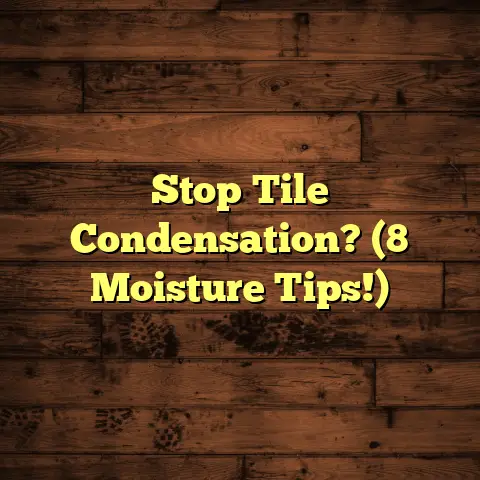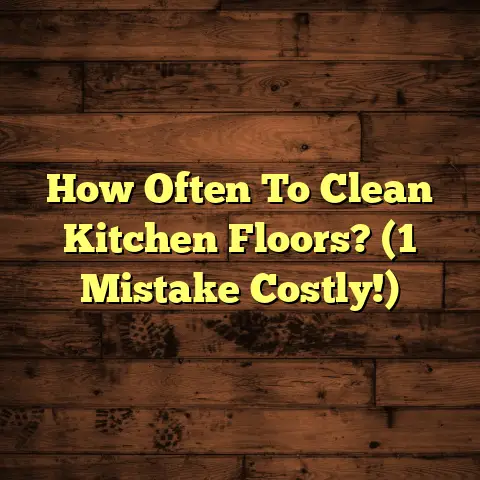Rubber Brush for Floors? (2 Best Uses!)
In a world obsessed with the newest gadgets, it’s funny how often the simplest tools still reign supreme.
Think about it: we have robot vacuums that map our homes and mops that steam away grime, yet the humble rubber brush continues to be a cleaning MVP.
This seemingly basic tool presents a conundrum: how can something so simple offer such profound benefits in floor care?
Let’s dive in and uncover the surprisingly powerful world of the rubber brush!
Introduction
Floor maintenance can feel like a never-ending battle, right? There’s always something: dust, dirt, pet hair, spills… the list goes on.
We’re constantly bombarded with new cleaning products and tools promising to make our lives easier.
And while some of these innovations are genuinely helpful, I’ve found myself returning to a classic tool time and time again: the rubber brush.
It’s a bit of an unsung hero in the cleaning world, often overlooked, but incredibly effective.
So, what exactly is a rubber brush?
It’s essentially a brush made with bristles or a blade of rubber or a rubber-like material.
The unique properties of rubber make it ideal for grabbing onto dirt, hair, and grime that other brushes might miss.
I’ve used them on all sorts of flooring, from hardwood to tile, and I’m always impressed with the results.
In this article, I’m going to share my expertise on using rubber brushes for floors.
I’ll cover what makes them so special, the two best uses I’ve found for them, and how to keep them in tip-top shape.
Ready to learn more? Let’s get started!
Section 1: Understanding the Rubber Brush
What is a Rubber Brush?
Okay, let’s get down to the basics.
What exactly is a rubber brush?
At its core, it’s a cleaning tool designed with rubber bristles or a rubber blade instead of traditional fiber bristles.
These bristles can vary in length, thickness, and pattern depending on the intended use.
The handle is usually made of plastic, wood, or metal, providing a comfortable grip for cleaning.
The real magic lies in the rubber itself. Rubber has a natural static charge that attracts and clings to dirt, dust, and hair.
It’s also flexible and durable, allowing it to conform to different surfaces and withstand repeated use.
Think of it like a squeegee combined with a brush.
Now, the history of the rubber brush isn’t exactly well-documented.
It’s not like someone invented it in a specific year and patented it.
But the concept of using rubber for cleaning has been around for a while.
Early versions might have been simple rubber blades used for wiping down surfaces.
Over time, the design evolved to include bristles and more ergonomic handles.
Today, you can find a variety of rubber brushes on the market, each designed for specific tasks.
Some have stiff bristles for scrubbing, while others have soft, flexible bristles for gentle cleaning.
You’ll also find rubber brooms with long handles for sweeping large areas and smaller handheld brushes for detail work.
Here’s a quick rundown of some common types:
-
Rubber Broom: A long-handled brush with a rubber blade or bristles, ideal for sweeping floors and removing pet hair.
-
Handheld Rubber Brush: A smaller brush with a handle, perfect for scrubbing grout, cleaning upholstery, or detailing car interiors.
-
Squeegee Brush: A combination of a rubber brush and a squeegee, designed for cleaning windows, mirrors, and shower doors.
No matter which type you choose, the underlying principle is the same: using the unique properties of rubber to effectively clean surfaces.
Why Choose a Rubber Brush?
So, with all the cleaning tools available, why should you choose a rubber brush?
I’ve found several compelling reasons over the years.
First and foremost, rubber brushes are incredibly effective at picking up pet hair.
As a pet owner myself, I know the struggle of constantly battling shedding.
Traditional brooms often just push the hair around, and vacuums can struggle with certain types of carpet.
Rubber brushes, on the other hand, grab onto the hair and pull it away from the fibers.
I’ve used them on carpets, rugs, and even upholstery with amazing results.
But the benefits don’t stop there.
Rubber brushes are also great for cleaning up dust, dirt, and other debris.
The flexible bristles can reach into corners and crevices that other tools might miss.
They’re also gentle on surfaces, making them suitable for delicate flooring like hardwood or laminate.
Compared to traditional brooms, rubber brushes are much easier to clean.
You can simply rinse them off with water and let them air dry.
No more dealing with tangled bristles or dust bunnies clinging to your broom!
And speaking of durability, rubber brushes are built to last.
The rubber material is resistant to wear and tear, so you won’t have to replace your brush as often as you would with a traditional broom.
Plus, many rubber brushes are made from recycled materials, making them an eco-friendly choice.
Here’s a quick comparison table to highlight the advantages of rubber brushes:
| Feature | Rubber Brush | Traditional Broom | Vacuum Cleaner |
|---|---|---|---|
| Pet Hair Removal | Excellent | Fair | Good (depending on model) |
| Dust & Dirt | Very Good | Good | Excellent |
| Surface Gentle | Yes | No (can scratch delicate surfaces) | Yes (depending on attachment) |
| Cleaning | Easy to rinse and clean | Difficult to clean | Requires emptying and filter cleaning |
| Durability | High | Moderate | Moderate to High |
| Eco-Friendly | Often made from recycled materials | Varies | Varies |
| Cost | Moderate (but lasts longer) | Low | Moderate to High |
As you can see, rubber brushes offer a unique combination of effectiveness, durability, and eco-friendliness.
For me, it’s a no-brainer to keep one on hand for all my floor cleaning needs.
Section 2: Best Uses of Rubber Brushes for Floors
Alright, let’s get to the heart of the matter: the best uses for rubber brushes on floors.
I’ve narrowed it down to two key areas where rubber brushes truly shine: pet hair removal and deep cleaning grout and tile.
Best Use #1: Pet Hair Removal
If you’re a pet owner, you know the struggle is real.
Pet hair seems to find its way into every nook and cranny of your home, clinging to carpets, embedding in upholstery, and drifting across hardwood floors like tumbleweeds.
It’s a constant battle, and traditional cleaning methods often fall short.
Vacuums can struggle with certain types of carpet, and brooms tend to just push the hair around.
That’s where the rubber brush comes in.
The rubber bristles create a static charge that attracts and grabs onto pet hair, lifting it away from surfaces with ease.
I’ve personally used rubber brushes on all types of flooring with great success.
On carpets, the bristles agitate the fibers, loosening embedded hair and allowing it to be swept up.
On hardwood and tile, the rubber creates friction that traps the hair, preventing it from scattering.
But it’s not just about the material; it’s also about the technique.
Here’s my step-by-step guide to effectively using a rubber brush for pet hair removal:
-
Choose the Right Brush: Opt for a rubber broom with a long handle for large areas or a handheld brush for detail work.
-
Prepare the Area: Remove any furniture or obstacles that might get in the way.
-
Sweep with Firm Pressure: Apply firm, even pressure as you sweep the brush across the floor. Use short, overlapping strokes to ensure you cover the entire area.
-
Vary Your Technique: For carpets, use a scrubbing motion to agitate the fibers and loosen embedded hair. For hardwood and tile, use a sweeping motion to trap the hair.
-
Clean the Brush Regularly: As you sweep, the brush will accumulate hair. Periodically remove the hair by hand or with a vacuum cleaner.
-
Focus on High-Traffic Areas: Pay special attention to areas where your pets spend the most time, such as near their beds or food bowls.
-
Frequency is Key: For optimal results, use the rubber brush regularly, ideally a few times a week.
Here are some additional tips for maintaining your rubber brush after use:
-
Rinse with Water: After each use, rinse the brush with water to remove any remaining hair or debris.
-
Air Dry: Allow the brush to air dry completely before storing it.
-
Store Properly: Store the brush in a cool, dry place to prevent the rubber from deteriorating.
With a little practice, you’ll become a pet hair removal pro in no time!
I’ve even seen some folks attach a microfiber cloth to the rubber broom for extra cleaning power.
It’s like a super-charged Swiffer!
Best Use #2: Deep Cleaning Grout and Tile
Okay, let’s move on to another common flooring challenge: dirty grout and tile.
Over time, grout can become stained and discolored by dirt, grime, and spills.
Tile can also accumulate a dull film that diminishes its shine.
Traditional cleaning methods often struggle to penetrate the porous surface of grout and remove stubborn stains.
That’s where the rubber brush can make a real difference.
The stiff, flexible bristles of a rubber brush are perfect for scrubbing grout lines and restoring the appearance of tiled floors.
I’ve used them to tackle everything from mild discoloration to stubborn mold and mildew.
Here’s my step-by-step cleaning process using a rubber brush for grout and tile:
-
Pre-Cleaning Preparations: Start by sweeping or vacuuming the floor to remove any loose dirt or debris.
-
Choose Your Cleaner: Select a grout and tile cleaner that is appropriate for your flooring type. You can use a commercially available cleaner or make your own using a mixture of baking soda and water or vinegar and water.
-
Apply the Cleaner: Apply the cleaner to the grout lines and tile surface, following the manufacturer’s instructions.
-
Scrub with the Rubber Brush: Use the rubber brush to scrub the grout lines and tile surface with firm, even pressure. Focus on areas with heavy staining or buildup.
-
Rinse Thoroughly: Rinse the floor with clean water to remove any remaining cleaner.
-
Dry the Floor: Use a clean towel or mop to dry the floor.
-
Repeat as Needed: For stubborn stains, you may need to repeat the process several times.
Here are some additional tips for tackling tough stains and buildup:
-
Let the Cleaner Soak: Allow the cleaner to soak on the grout lines for several minutes before scrubbing.
-
Use a Stiff-Bristled Brush: For heavily stained grout, use a rubber brush with stiff bristles for extra scrubbing power.
-
Consider a Grout Pen: For small areas of discoloration, use a grout pen to touch up the grout lines.
-
Ventilate the Area: Make sure the area is well-ventilated while you’re cleaning.
And here’s a pro tip: I like to use an old toothbrush in combination with the rubber brush for really tight spots.
It’s a great way to get into those hard- to-reach corners!
After cleaning, it’s important to properly care for your tiles and grout to prevent future staining and buildup.
Here are some tips for post-cleaning care:
-
Seal the Grout: Apply a grout sealer to protect the grout from future staining.
-
Clean Spills Immediately: Wipe up spills as soon as they occur to prevent them from soaking into the grout.
-
Regularly Sweep or Vacuum: Sweep or vacuum the floor regularly to remove loose dirt and debris.
-
Use a Neutral Cleaner: When cleaning the floor, use a neutral cleaner that won’t damage the tile or grout.
With a little elbow grease and the help of a rubber brush, you can restore your tiled floors to their former glory!
Section 3: Real-Life Applications and Testimonials
Okay, so I’ve told you all about the benefits of rubber brushes, but what do other people think?
I’ve gathered some anecdotes and quotes from individuals who have successfully used rubber brushes for floor cleaning.
These stories come from a variety of flooring scenarios, including homes with pets, high-traffic areas, and even commercial spaces.
Let’s start with Sarah, a pet owner with two shedding dogs:
“I was constantly battling pet hair on my carpets and hardwood floors. I tried everything, but nothing seemed to work. Then I discovered the rubber broom, and it was a game-changer! It picks up hair that my vacuum misses, and it’s so easy to clean. I highly recommend it to any pet owner.”
Next up is Mark, who owns a small restaurant with tiled floors:
“Our tiled floors get a lot of foot traffic, and the grout was constantly getting dirty. We tried all sorts of cleaners, but nothing seemed to work. Then we tried using a rubber brush to scrub the grout, and it made a huge difference! The grout looks so much cleaner, and the floors are much easier to maintain.”
And finally, here’s Lisa, who has hardwood floors in her home:
“I was always worried about scratching my hardwood floors with a traditional broom. But the rubber brush is so gentle, and it does a great job of picking up dust and dirt. I use it every day, and my floors look amazing.”
These are just a few examples of how rubber brushes can be used to effectively clean floors in a variety of scenarios.
But don’t just take my word for it.
Try a rubber brush for yourself and see the difference it can make!
To help visualize the process and results, I’ve included some descriptive language below:
-
Imagine: A rubber broom effortlessly gliding across a carpet, lifting embedded pet hair with each stroke.
-
Picture: A handheld rubber brush scrubbing grout lines, revealing clean, bright grout underneath.
-
Visualize: A tiled floor gleaming after being cleaned with a rubber brush, free from dirt and grime.
These images should give you a better sense of the effectiveness and versatility of rubber brushes for floor cleaning.
Section 4: Maintenance and Care of Rubber Brushes
Okay, so you’ve invested in a rubber brush and you’re ready to start cleaning.
But how do you keep your brush in tip-top shape?
Proper maintenance and care are essential for prolonging the lifespan of your rubber brush and ensuring its effectiveness.
Here are some tips for cleaning and maintaining your rubber brush:
-
Rinse After Each Use: After each use, rinse the brush with water to remove any remaining dirt, hair, or debris.
-
Remove Embedded Debris: Use your fingers or a small tool to remove any embedded debris from the bristles.
-
Wash with Soap and Water: Periodically wash the brush with soap and water to remove any buildup of dirt or grime.
-
Disinfect as Needed: If you’re using the brush to clean up messes that may contain bacteria or germs, disinfect it with a bleach solution or other disinfectant.
-
Air Dry Completely: Allow the brush to air dry completely before storing it.
-
Store Properly: Store the brush in a cool, dry place to prevent the rubber from deteriorating.
Regular maintenance is crucial for effective floor cleaning.
A dirty or damaged brush won’t be as effective at picking up dirt and hair.
Plus, a well-maintained brush will last longer, saving you money in the long run.
Here are some additional tips on storing rubber brushes appropriately:
-
Avoid Direct Sunlight: Direct sunlight can cause the rubber to dry out and crack.
-
Keep Away from Heat: Excessive heat can also damage the rubber.
-
Hang or Store Upright: Hanging the brush or storing it upright will prevent the bristles from bending or becoming misshapen.
-
Protect from Chemicals: Avoid storing the brush near harsh chemicals, as they can damage the rubber.
By following these simple maintenance and care tips, you can keep your rubber brush in prime condition for years to come.
Conclusion
So, we’ve come full circle.
We started with a paradox: in a world of high-tech cleaning gadgets, why does the humble rubber brush still reign supreme?
The answer, I believe, lies in its simplicity and effectiveness.
Rubber brushes are incredibly versatile tools that can be used to tackle a variety of flooring challenges.
From removing pet hair to deep cleaning grout and tile, they offer a unique combination of effectiveness, durability, and eco-friendliness.
I encourage you to consider incorporating a rubber brush into your cleaning routine.
You might be surprised at how much of a difference it can make!
Sometimes, the simplest tools really are the best.





